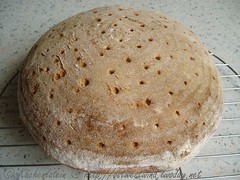| -========= | REZKONV-Recipe – RezkonvSuite v1.4  |
| Title: | Czech Country Bread – Žitný chleba |
| Categories: | Bread, Sourdough |
| Yield: | 2 Rounds à 482 grams or 1 round about 960 grams |
 |
 |
Ingredients
| 150 | grams | Rye sourdough 133 % Hydration | |
| 300 | grams | Water, tepid | |
| 1/2 | teasp. | Dry yeast | |
| 400 | grams | Unbleached bread flour, preferably high-gluten | |
| 100 | grams | White rye flour | |
| 10 | grams | Sea salt |
Source
 * * |
modified version of Daniel Leader, Local Breads: Sourdough and Whole-Grain Recipes from Europe’s Best Artisan Bakers * ISBN 978-0393050554 |
Directions
REFRESH THE RYE SOURDOUGH. Eight to 12 hours before you want to mix your dough, refresh the rye sourdough. I used 10 g starter 100 % Hydration + 64 grams medium rye flour + 86 grams water in the bowl of the KitchenAid.
MIX THE DOUGH: Stir the rye sourdough to invigorate and deflate it. Pour the water over the sourdough. Stir in the yeast, bread flour, rye flour, and salt with a rubber spatula just until a dough forms.
KNEAD THE DOUGH. By hand: Lightly dust a clean counter with flour. Scrape the dough out of the bowl and knead it with smooth, steady strokes for 8 minutes. The rye flour will cause the dough to be fairly sticky. As you work, keep your hands floured but resist adding a lot of flour. Lightly drape the dough with plastic wrap and let it rest for 10 minutes. Remove the plastic and knead again until the dough is smooth and elastic, 5 to 7 minutes more.
By machine: Use the dough hook and mix the dough on medium-low speed (4 on a KitchenAid mixer) for 7 minutes. Turn off the machine and scrape down the hook and sides of the bowl with a rubber spatula. Lightly cover the dough with a piece of plastic wrap and let it rest for 10 minutes. Remove the plastic, turn the mixer back on to mediumlow, and knead until the dough is smooth and elastic, 3 to 5 minutes more.
FERMENT THE DOUGH. Transfer the dough to a lightly oiled, clear 2quart container with a lid. With masking tape, mark the spot on the container that the dough will reach when it has doubled in volume. Cover and leave it to rise at room temperature until it doubles, reaching the masking tape mark, 2 to 2 1/2 hours. It won’t feel as sticky.
DIVIDE AND SHAPE THE LOAVES. Cover a baker’s peel or rimless baking sheet pith parchment paper. Set aside. Lightly dust the counter with rye flour. Scrape the dough onto the counter and cut it into 2 equal pieces à 482 grams each or one large round. With a bench scraper or a chef’s knife. Shape each piece into a round.
PROOF THE LOAVES. Dust the parchment paper lightly with rye flour and place the loaves on the paper about 3 inches apart, smooth side up. Sift some more rye flour over the loaves, as if you wem dusting; them with confectioners‘ sugar. Lightly cover them with plastic wrap. Leave the loaves to rise at room temperature until they have inflated and bubbles are visible just below the surface, 1 to 1 1/2 hours. At this point, when you press a fingertip into the dough it will spring back slowly.
PREPARE THE OVEN. About 1 hour before baking, place a baking stone on the middle rack of the oven and a cast-iron skillet on the lower rack. Heat the oven to 220 °C.
DOCK THE LOAVES. Use a pastry docker or skewer to poke about 20 holes, about 1 cm apart from each other, all over the tops of the loaves.
BAKE THE LOAVES. Slide the bases, still on the parchment. onto the baking stone. Place 3/4 cup of ice cubes in the skillet to produce steam. Bake until the loaves are ruddy brown, 30 to 40 minutes to an internal temperature of 90 °C.
COOL AND STORE THE LOAVES. Slide the peel or the rimless baking sheet under the parchment paper to remove the loaves from the oven. Slide the loaves, still on the parchment, onto a wire rack. Cool for about 5 minutes and then peel them off the parchment paper. Cool them completely on the wire rack, about 1 hour, before slicing. Store the loaves at room temperature in a brown paper bag for 3 to 4 days, or freeze in resealable plastic bags for up to month.
=====
*=Affiliate-Link zu Amazon

